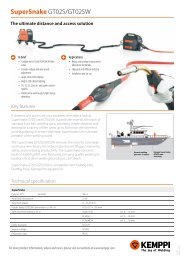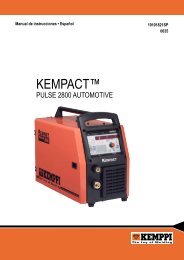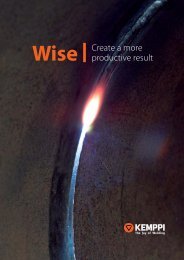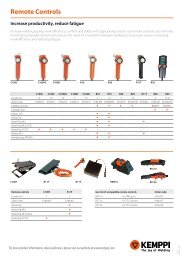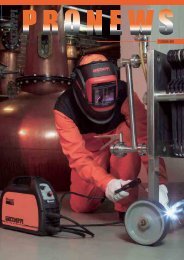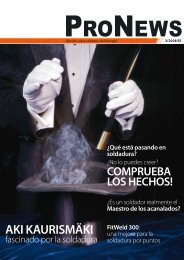You also want an ePaper? Increase the reach of your titles
YUMPU automatically turns print PDFs into web optimized ePapers that Google loves.
12<br />
<strong>Kemppi</strong> ProNews 2 • 2006<br />
welding arc voltage is low, the above problem<br />
rarely has any real impact. Current AC TIG machines<br />
use a squarewave or modifi ed squarewave, whose rising<br />
and falling edges are extremely steep. As a result an<br />
AC TIG can in some circumstances be sensitive to cable<br />
length, for reasons which are addressed in connection<br />
with pulse MIG welding.<br />
MIG/MAG welding and pulse MIG welding<br />
Conventional MIG/MAG welding uses a constant voltage<br />
rectifi er, whose generated voltage depends very little<br />
on the current. In addition to this, the conventional MIG/<br />
MAG process only works well with a constant voltage<br />
rectifi er. As a result, the MIG/MAG process is considerably<br />
more sensitive to cable loss than the MMA process.<br />
Short arc welding in particular is, merely due to its<br />
low voltage, more sensitive to cable loss than a spray arc<br />
process, which allows signifi cant cable losses in practical<br />
use. In either case cable loss can be compensated by<br />
increasing the voltage of the power source. Flux-cored<br />
welding works well with very long cables; it is here that<br />
fl ux-cored welding is more reminiscent of MMA welding<br />
than short arc welding.<br />
In pulse MIG welding cable impact differs considerably<br />
from other processes. It is for this reason that the matter<br />
will be discussed in greater detail below.<br />
Dynamic losses<br />
If pure DC is running through the wires or the current<br />
changes slowly, the wires’ voltage loss can be calculated<br />
as a product of the wire resistance and current. Indeed<br />
this is precisely the point in MMA and DC TIG welding.<br />
On the other hand, current changes in short arc MIG/<br />
MAG and pulse MIG welding are so fast that the impact<br />
of the changes must be given attention. The physical<br />
explanation of the phenomenon is that current running<br />
through a wire generates a magnetic fi eld, whose changing<br />
requires energy that must fed into the fi eld with a cable.<br />
This always takes time. If the welding current needs<br />
to be altered suddenly, such as with a pulse MIG, the<br />
current and the magnetic fi eld energy must be altered at<br />
the same time.<br />
The longer the cables are, the greater the amount of energy<br />
that needs to be moved and the more time it takes.<br />
The technical term describing the slowness of the abovementioned<br />
change in current is called inductance. It is<br />
determined by not only the cable length, but also its diameter<br />
and placement. Inductance is at its lowest level<br />
when the cable is routed in a hairpin loop or a single<br />
large loop. If the cable is instead reeled, inductance can<br />
rise to a very high level. This is illustrated in Figure 4.<br />
According to one laboratory measurement, a 25 m cable<br />
routed as shown in Figure 3B generated an inductance<br />
of 20 μH, but when reeled as shown in Figure 3C the<br />
same cable’s inductance was 110 μH, i.e. over fi ve times<br />
more. Although this kind of increase in inductance will<br />
cause a noticeable change in short arc welding, it will<br />
not make welding impossible. However, the impact this<br />
has on pulse MIG welding is so powerful that it is for all<br />
intents and purpose no longer possible to weld properly.<br />
The inductance of a reeled cable depends on the length<br />
of the cable, primarily due to the fact that doubling the<br />
length of a cable coiled around a reel effectively quadruples<br />
the inductance. The impact that the reel dimensions<br />
and placement have is minimal compared to cable<br />
length. It makes no real difference whether a cable reel<br />
is coiled around the bars of a transport cart or lying on<br />
the fl oor.<br />
Increasing the cable’s copper cross-section reduces inductance<br />
only marginally. Where practical work is concerned,<br />
it is recommended that welding cables be kept<br />
as short as possible. A better alternative to reeling is to<br />
shorten excess cable, provided that the power source is<br />
close to the welding point. If it is for some reason impossible<br />
to cut any excess cable, uncoiling the cable into<br />
loops (as shown in Figure 3A or 3B) will signifi cantly<br />
reduce inductance. An excellent way to reduce cable inductance<br />
is to connect the return lead to the workpiece<br />
next to the power source, if possible. According to fi ndings,<br />
a workshop scale workpiece also serves as an excellent<br />
return lead where inductance is concerned. In this<br />
case only the torch cable has an impact on inductance.<br />
Below is an examination of how cable inductance is<br />
dependent on cable geometry. The external inductance<br />
of the cable in Figure 3A can only be calculated using<br />
the law of perforation, thus resulting in the following<br />
inductance formula:<br />
L = u0*l*ln(a/r0)/pi (1)<br />
where<br />
u0 vacuum permeance<br />
l loop length (half the cable length)<br />
a distance between the cables<br />
r0 cable copper cross-section<br />
In addition to this, the situation is also affected by frequency-dependent<br />
internal inductance, for which the<br />
formula is:<br />
Z = (k*l)/(2*pi*r0*s)*J0(k*r0)/J1(k*r0) (2)<br />
where<br />
Z cable inductance<br />
k (1-j)sqr(f*s*u)<br />
s conductivity<br />
J0 and J1 Bessel function of the first kind<br />
At low frequencies (abs(k)



